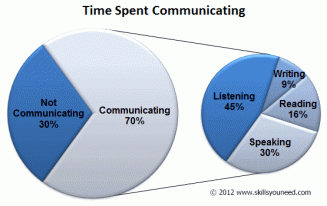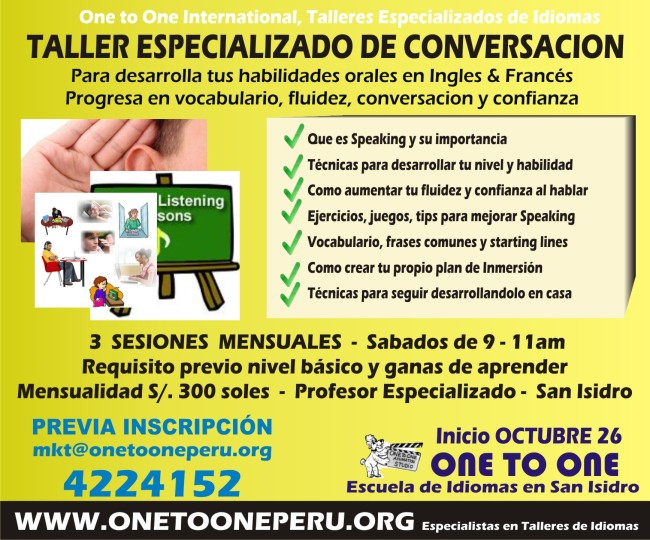Aqui nuestro post sobre el Taller Especializado en LISTENING EN INGLES, en total fueron 3 sesiones de Octubre a Noviembre, los cuales fueron todo un exito. Pudimos tocar puntos como:
- Comunes dificultades que participantes encontraron muy similares cuando no pueden entender a extranjeros u otras personas en inglés, especialmente cuando viajan, visitas de negocios, trabajo, teleconferencias, en trabajo.
- Como la correcta pronunciacion puede influir en tu habilidad para entender listening.
- Diferencia entre Hearing & Listening – Active & Effective Listening.
- Distractors comunes que impiden que tengamos un Effective Listening.
- Como habitos y costumbres de nuestra cultura Peruana afectan la manera de comprender y entender Listening en Ingles
- Consejos, ejercicios, juegos, tips para desarrollar durante la semana hasta nuestra proxima sesion.
Aquí parte de la separata que recibieron nuestros participantes en esta primera sesión con temas muy interesantes.
“The most basic and powerful way to connect to another person is to listen. Just listen. Perhaps the most important thing we ever give each other is our attention.” by Rachel.
Listening is Not the Same as Hearing
Hearing refers to the sounds that you hear, whereas Listening requires more than that: it requires focus. Listening means paying attention not only to the story, but how it is told, the use of language and voice, and how the other person uses his or her body. In other words, it means being aware of both verbal and non-verbal messages. Your ability to listen effectively depends on the degree to which you perceive and understand these messages
Listening is Not the same as Speaking
Listening is the step of speaking without listening you cannot Speak but with great listening you can speak better. Listeningis getting information on a receiving end, while Speaking is exposing information on a giving end. If you are Listening, your mouth is shut, if you are Speaking, it is moving with words coming out. Adults spend an average of 70% of their time engaged in some sort of communication, of this an average of 45% is spent listening compared to 30% speaking, 16% reading and 9% writing. (Adler, R. et al. 2001).
COMMON EFFECTIVE LISTENING BARRIERS
It is common, when listening to someone else speak, to be formulating a reply whilst the other person is still talking. However, this means that we are not really listening to all that is being said. Even good listeners are often guilty of critically evaluating what is being said before fully understanding the message that the speaker is trying to communicate. The result is that assumptions are made and conclusions reached about the speaker’s meaning that might be inaccurate.
- Trying to listen to more than one conversation at a time, this includes having the television or radio on while attempting to listen to somebody talk; being on the phone to one person and talking to another person in the same room and also being distracted by some dominant noise in the immediate environment.
- You find the communicator attractive/unattractive and you pay more attention to how you feel about the communicator and their physical appearance than to what they are saying. Perhaps you simply don’t like the speaker – you may mentally argue with the speaker and be fast to criticize, either verbally or in your head.
- You are not interested in the topic/issue being discussed and become bored.
- Not focusing and being easily distracted, fiddling with your hair, fingers, a pen etc. or gazing out of the window or focusing on objects other than the speaker.
- Feeling unwell or tired, hungry, thirsty or needing to use the toilet.
- Identifying rather than empathizing, understanding what you are hearing but not putting yourself in the shoes of the speaker. As most of us have a lot of internal self-dialogue we spend a lot of time listening to our own thoughts and feelings – it can be difficult to switch the focus from ‘I’ or ‘me’ to ‘them’ or ‘you’. Effective listening involves opening your mind to the views of others and attempting to feel empathetic.
- Sympathizing rather than empathizing, sympathy is not the same as empathy, you sympathize when you feel sorry for the experiences of another, to empathize is to put yourself in the position of the other person.
- You are prejudiced or biased by race, gender, age, religion, accent, and/or past experiences.
- You have preconceived ideas or bias. Effective listening includes being open-minded to the ideas and opinions of others, this does not mean you have to agree but should listen and attempt to understand.
- You make judgments, thinking, for example that a person is not very bright or is under-qualified so there is no point listening to what they have to say.
MAIN MISCONCEPTIONS ABOUT LISTENING
It’s Difficult to Learn How to Listen = We all learn to listen from an early age. How well we listen depends on the circumstances of the communication, our motivation to listen and our personalities. Listening becomes so natural that we can develop bad habits and become blasé about the process. The skills needed for effective listening are not difficult to learn – the key to developing your listening skills is practice and consistently applying good listening skills across all communication situations. It is worth the effort to learn and practice how to listen.
I’m a Good Listener = Generally people overestimate their own listening abilities and underestimate the listening abilities of others. In other words, we tend to think that we are better listeners than other people. This means that other people tend to think that they are better listeners than you. Effective listening can only be measured by the understanding that you gain – this will inevitably vary for different situations and for different people. Good listening is not a skill that we are born with; it is not a natural gift. Without practice and training we are unlikely to be particularly effective listeners.
Intelligent People are Better Listeners = There is no link between traditional measures of cognitive ability, intelligence – (IQ), and how well we listen. Although being bright and having a good vocabulary may make it easier to process information and gain understanding, these qualities do not necessarily make clever people better listeners. For example, very intelligent people may be more likely to get bored with a conversation and ‘tune out’, thinking about other things and therefore not listening.
Gender Affects Listening Ability = Generally, and without trying to stereotype, men and women value communication differently. Women tend to place a higher value on connection, cooperation and emotional messages, whereas men are generally more concerned with facts and may be uncomfortable talking about and listening to personal or emotional subjects. This doesn’t mean that women are better listeners than men, or vice-versa, but that there may be differences in the ways in which messages are interpreted. During a conversation men and women are likely to ask different types of questions of the speaker to clarify the message – their final interpretation of the conversation may, therefore, be different.
EFFECTIVE LISTENING AND SIGNS
Effective listening requires concentration and the use of your other senses – not just hearing the words spoken. Listening is not the same as hearing and in order to listen effectively you need to use more than just your ears. A good listener will listen not only to what is being said, but also to what is left unsaid or only partially said. Effective listening involves observing body language and noticing inconsistencies between verbal and non-verbal messages. For example, if someone tells you that they are happy with their life but through gritted teeth or with tears filling their eyes, you should consider that the verbal and non-verbal messages are in conflict, they maybe don’t mean what they say.
1. Stop Talking = “If we were supposed to talk more than we listen, we would have two tongues and one ear.” Mark Twain. Don’t talk, listen. When somebody else is talking listen to what they are saying, do not interrupt, talk over them or finish their sentences for them. Stop, just listen. When the other person has finished talking you may need to clarify to ensure you have received their message accurately.
2. Prepare Yourself to Listen = Relax. Focus on the speaker. Put other things out of mind. The human mind is easily distracted by other thoughts – what’s for lunch, what time do I need to leave to catch my train, is it going to rain – try to put other thoughts out of mind and concentrate on the messages that are being communicated.
3. Put the Speaker at Ease = Help the speaker to feel free to speak. Remember their needs and concerns. Nod or use other gestures or words to encourage them to continue. Maintain eye contact but don’t stare – show you are listening and understanding what is being said.
4. Remove Distractions = Focus on what is being said: don’t doodle, shuffle papers, look out the window, pick your fingernails or similar. Avoid unnecessary interruptions. These behaviours disrupt the listening process and send messages to the speaker that you are bored or distracted.
5. Empathize = Try to understand the other person’s point of view. Look at issues from their perspective. Let go of preconceived ideas. By having an open mind we can more fully empathise with the speaker. If the speaker says something that you disagree with then wait and construct an argument to counter what is said but keep an open mind to the views and opinions of others.
6. Be Patient = A pause, even a long pause, does not necessarily mean that the speaker has finished. Be patient and let the speaker continue in their own time, sometimes it takes time to formulate what to say and how to say it. Never interrupt or finish a sentence for someone.
7. Avoid Personal Prejudice = Try to be impartial. Don’t become irritated and don’t let the person’s habits or mannerisms distract you from what they are really saying. Everybody has a different way of speaking – some people are for example more nervous or shy than others, some have regional accents or make excessive arm movements, some people like to pace whilst talking – others like to sit still. Focus on what is being said and try to ignore styles of delivery.
8. Listen to the Tone = Volume and tone both add to what someone is saying. A good speaker will use both volume and tone to their advantage to keep an audience attentive; everybody will use pitch, tone and volume of voice in certain situations – let these help you to understand the emphasis of what is being said.
9. Listen for Ideas = Not Just Words = You need to get the whole picture, not just isolated bits and pieces. Maybe one of the most difficult aspects of listening is the ability to link together pieces of information to reveal the ideas of others. With proper concentration, letting go of distractions, and focus this becomes easier.
10. Wait and Watch for Non-Verbal Communication = Gestures, facial expressions, and eye-movements can all be important. We don’t just listen with our ears but also with our eyes – watch and pick up the additional information being transmitted via non-verbal communication.
Para aquellos interesados en mejorar su habilidad auditiva en ingles y frances, aun estan a tiempo de inscribirse y participar en las sesiones de Diciembre, especialmente durante este mes que siempre nos olvidamos de practicar idiomas por tantos compromisos. Aqui los detalles……….Webmaster
Taller Especializado para mejorar LISTENING en Ingles y Frances
Inscripciones e Informes al: 422-4152 – mkt@onetooneperu.org – Costo por persona S/. 300 (3 sesiones)
FB: https://www.facebook.com/events/1423892321167567/?context=create
http://www.onetooneperu.org/talleres_novedades.htm
BLOG: http://onetoonelanguages.wordpress.com/
Obligatorio enviarnos pago y voucher escaneado minino 1 semana antes – Cuenta BCP: 193-1652-7908-055
Tambien pueden participar en nuestros TALLERES para mejorar CONVERSACION & FLUIDEZ INGLES, FRANCES






